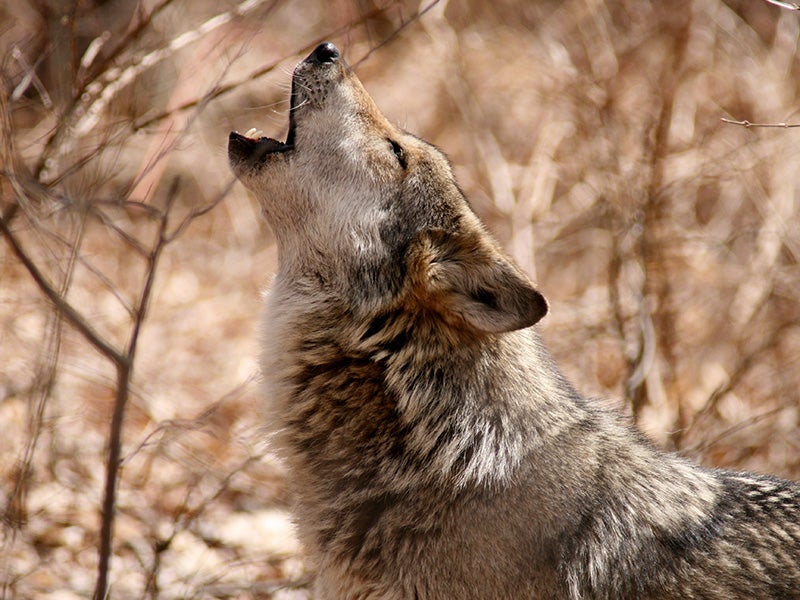Court Rejects Flawed Mexican Gray Wolf Rule
Victory
—Ruling rejects measures that hurt, instead of help, rare wolves
Contact
A federal judge today rejected provisions in a 2015 federal management rule that unlawfully imposed roadblocks to recovery of the endangered Mexican wolf. The rule arbitrarily limited the lobos’ population numbers, banned them from needed recovery habitat, and loosened the rules against killing the animals in the wild.
Today’s decision by U.S. District Court Judge Jennifer Zipps ruled that imposing these measures violated the U.S. Fish and Wildlife Service’s duty under the Endangered Species Act to recover the Mexican wolf from its current status as one of the most endangered mammals in North America. There were once thousands of the wolves living in America’s Southwest and now there are only about 100 left.
The judge particularly faulted government officials for disregarding the advice of expert scientists who warned that the new management rule would hinder the Mexican wolf’s recovery. Judge Zipps said, “This case is unique in that the same scientists that are cited by the agency publicly communicated their concern that the agency misapplied and misinterpreted findings in such a manner that the recovery of the species is compromised. To ignore this dire warning was an egregious oversight by the agency.”
The judge ordered government officials to revise the rule in response to her ruling and ordered the parties to the case to report back in 30 days with a proposed deadline for that revision.
“This ruling offers hope that the Mexican wolf can be pulled back from the brink of extinction before it is too late,” said Earthjustice attorney Timothy Preso, who argued the case for conservationists. “The judge made clear that management of the lobo must follow the law and the science on Mexican wolf recovery instead of giving in to the political demands of wolf foes.”
Today’s ruling came in response to a lawsuit filed by Earthjustice on behalf of the Center for Biological Diversity and Defenders of Wildlife.
“This decision makes clear that the Fish and Wildlife Service has to do more to protect and recover endangered Mexican wolves,” said Andrea Santarsiere, a senior attorney at the Center for Biological Diversity. “With only 114 Mexican wolves left in the wild, the government cannot take a slow and incremental approach to recovery. We need more wolves in more places, including the Grand Canyon in Arizona and southern Rockies in New Mexico.”
“The court today reversed what seemed a dim future for the Mexican gray wolf in the Southwestern U.S.,” said Bryan Bird, Southwest Program Director for Defenders of Wildlife. “If the lobo is going to have a real chance at recovery, it needs room to roam and protection from unnecessary persecution.”
Background:
The Mexican gray wolf is one of the most endangered mammals in North America. At last count, only 113 Mexican wolves survived in the Southwest in a single, small population occupying the Blue Range of eastern Arizona and western New Mexico. This population is beset by numerous threats, including widespread illegal killing as well as inbreeding caused by inadequate releases of more genetically diverse wolves from a captive population.
The Fish and Wildlife Service issued a new management rule for the wild Mexican wolf population in January 2015. While the Endangered Species Act mandates that such rules provide for the survival and recovery of the species, the 2015 plan hindered Mexican wolf recovery through measures that the most expert wolf biologists deemed inadequate. Among other things, the 2015 plan:
- Capped the reintroduced population at 325 wolves, a level that scientists have demonstrated to be too low for long-term survival, let alone recovery;
- Barred wolf dispersal north of I-40, where essential recovery habitat for the species is located;
- Expanded opportunities for killing wolves without any safeguards in place to prevent the loss of genetically important individuals.
These measures, by themselves and cumulatively, threatened to prevent recovery of the Mexican gray wolf, consigning the species to a perpetual battle for survival.

Additional Resources
About Earthjustice
Earthjustice is the premier nonprofit environmental law organization. We wield the power of law and the strength of partnership to protect people's health, to preserve magnificent places and wildlife, to advance clean energy, and to combat climate change. We are here because the earth needs a good lawyer.